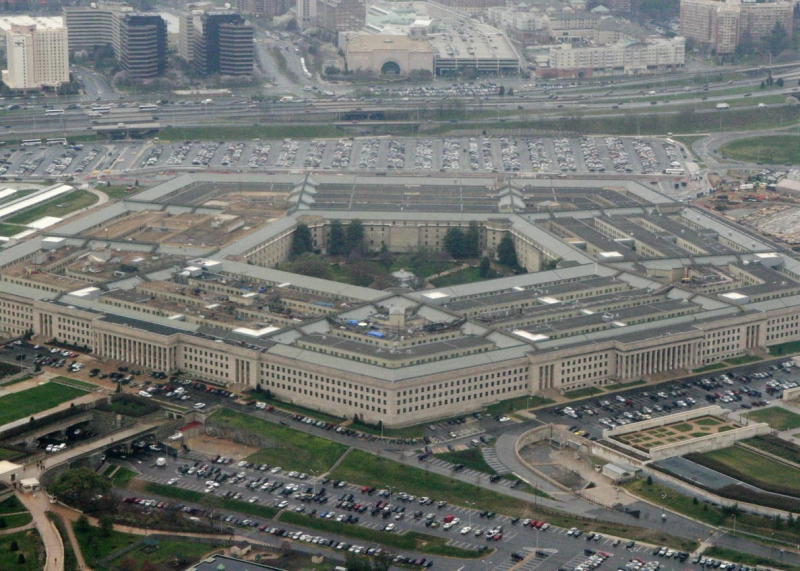- NCP Khulna Chief Critically Shot Amid Rising Political Violence |
- Indian MP Warns Bangladesh Faces Rising Lawlessness |
- Law and Order Must Be Ensured Ahead of Polls: Prof Yunus |
- Tough times ahead, everyone must remain united: Tarique Rahman |
- Sirajganj’s luxuriant mustard fields bloom as an oasis of gold |
US military aircraft drop thousands of meals into Gaza in emergency aid

The Pentagon in Washington.
WASHINGTON, Mar 2 (AP/UNB) — U.S. military C-130 cargo planes dropped food in pallets over Gaza on Saturday in the opening stage of an emergency humanitarian assistance authorized by President Joe Biden after more than 100 Palestinians who had surged to pull goods off an aid convoy were killed during a chaotic encounter with Israeli troops.
Three planes from Air Forces Central dropped 66 bundles containing about 38,000 meals into Gaza at 8:30 a.m. EST (3:30 p.m. local). The bundles were dropped in southwest Gaza, on the beach along the territory's Mediterranean coast, one U.S. official said. The airdrop was coordinated with the Royal Jordanian Air Force, which said it had two food airdrops Saturday in northern Gaza and has conducted several rounds in recent months.
“The combined operation included U.S. Air Force and RJAF C-130 aircraft and respective Army Soldiers specialized in aerial delivery of supplies, built bundles and ensured the safe drop of food aid,” U.S. Central Command said in a post on "X", formerly known as Twitter.
The airdrop is expected to be the first of many, U.S. Central Command said.
President Joe Biden on Friday announced the U.S. would begin air dropping food to starving Gazans after at least 115 Palestinians were killed and hundreds more wounded in the Thursday attack as they scrambled for aid, the Health Ministry in Hamas-ruled Gaza said.
Hundreds of people had rushed about 30 trucks bringing a predawn delivery of aid to the north. Palestinians said nearby Israeli troops shot into the crowds. Israel said they fired warning shots toward the crowd and insisted many of the dead were trampled.
White House national security spokesperson John Kirby said Friday that the airdrops were being planned to deliver emergency humanitarian assistance in a safe way to people on the ground. The United States believes the airdrops will help address the dire situation in Gaza, but they are no replacement for trucks, which can transport far more aid more effectively, though Thursday’s events also showed the risks with ground transport.
Kirby said the airdrops have an advantage over trucks because planes can move aid to a particular location very quickly. But in terms of volume, the airdrops will be “a supplement to, not a replacement for moving things in by ground.”
The C-130 is widely used to deliver aid to remote places because of its ability to land in austere environments.
A C-130 can airlift as much as 42,000 pounds of cargo and its crews know how to rig the cargo, which sometimes can include even vehicles, onto massive pallets that can be safely dropped out of the back of the aircraft.
Air Force loadmasters secure the bundles onto pallets with netting that is rigged for release in the back of a C-130, and then crews release it with a parachute when the aircraft reaches the intended delivery zone.
The Air Force's C-130 has been used in years past to air drop humanitarian into Afghanistan, Iraq, Haiti and other locations and the airframe is used in an annual multi-national “Operation Christmas Drop” that air drops pallets of toys, supplies, nonperishable food and fishing supplies to remote locations in the Federated States of Micronesia and the Republic of Palau.
Since the war began on Oct. 7, Israel has barred entry of food, water, medicine and other supplies, except for a trickle of aid entering the south from Egypt at the Rafah crossing and Israel’s Kerem Shalom crossing.
The United Nations says one-quarter of Gaza’s 2.3 million people face starvation. Aid officials have said that airdrops are not an efficient means of distributing aid and are a measure of last resort.

